- Home
- Markets and prices
- Cereals and oilseeds markets - Supply and demand - Crop development
Crop development
July 2024
The interactive tool at the bottom of this page helps show the condition and growth stages of different crops across GB. The chart is split into regions and uses colours to show different conditions. You can also use the bottom chart to see growth stages of cereals or oilseeds.
Overview
Winter combinable crops in the UK suffered a lot of very wet weather this year, from planting and establishment through to late March and beyond. As a result, crop conditions are more varied than usual. The crops now, are not the best we have ever seen, but have surprised many people with their improvement from earlier in the year. Whilst some parts of the country are looking more or less as they should, there are notable bare patches and large gaps, particularly in wet corners and headlands across several regions. Central England is particularly affected. As mentioned in previous analysis, leafy crops do not always translate into high yields, and we do not expect records this year.
Throughout the UK, the variation in winter crop condition is striking. Differences in soil types, drilling dates and subsequent rainfall significantly affected crop establishment. Additionally, these factors have hindered growers’ ability to apply treatments in a timely manner both pre- and post- emergence. Most inputs have now been applied to all crops, perhaps excepting the pre-harvest treatments.
The crops have all caught up with their normal crop development progress and are on track for a timely harvest having sped through some growth stages at a remarkable pace. How much this will have impacted yield is yet to be seen.
The effects of a difficult winter for much of the UK were felt long into the spring. Saturated soils and compaction issues due to heavy rainfall caused delays in spring drilling across many regions. However, conditions eventually improved, allowing most spring crops to be established in good order.
Many in Scotland, a country dominated by spring crops, are pleased with crop performance so far. Ploughing and therefore drilling was late, but crops are looking healthy and full. Welsh and Northern Irish crops are not looking so strong but have rebounded since spring weather settled a little more.
The information in this report was captured up to Wednesday 3 July 2024 for AHDB by The Andersons Centre. Key differences between crops are explored below, with more detail in the full report.
Crop condition definitions
Crop condition was assessed using the USDA approach. This classifies crops into one of five categories, from very poor through to excellent (see details below). The values are given as the percentage of the GB crop area for that crop that falls in each of the categories – regional condition scores are available on the crop reporting dashboard at the bottom of this page.
- Very Poor - Extreme degree of loss to yield potential, complete or near crop failure.
- Poor - Heavy degree of loss to yield potential, which can be caused by excess soil moisture, drought, disease, etc.
- Fair - Less than normal crop condition. Yield loss is a possibility, but the extent is unknown.
- Good - Yield prospects are normal. Moisture levels are adequate and disease, insect damage, and weed pressures are minor.
- Excellent - Yield prospects are above normal. Crops are experiencing little or no stress. Disease, insect damage, and weed pressures are insignificant.
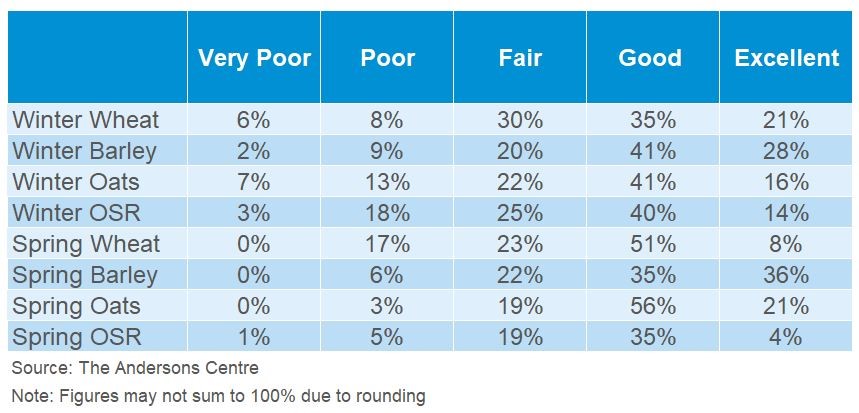
From March 2024, the survey work was undertaken by The Andersons Centre, while for previous years the survey work was undertaken by RSK ADAS; please take this into consideration when comparing to historical figures.
Wheat
Nationally, 56% of winter wheat is rated as either good or excellent, up slightly from 55% last month. This remains well below the same time last year (week ending 4 July 2023), when 76% of the crop was rated in this condition.
Many winter wheat fields are not looking as tidy as usual or as many farmers would wish their crops to look at this time of year. The fact that most fields have a crop at all is, in some parts of the UK a surprise to many who expected more fallow and failed crops given the situation earlier in the year. Those who kept investing in their winter wheat are largely pleased with their decisions.
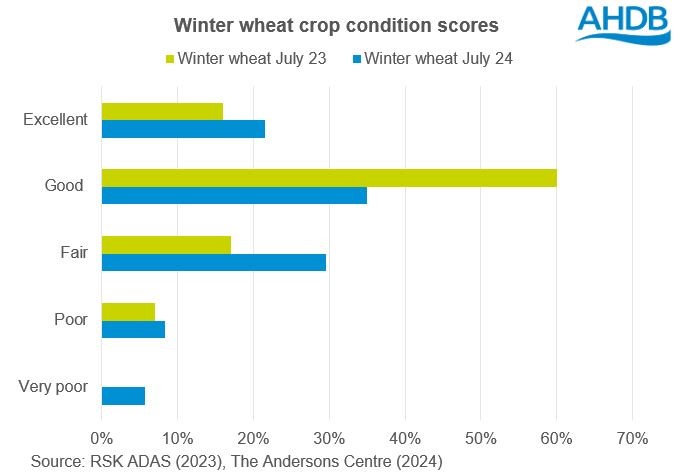
Spring wheats are looking well, with 59% of crops across GB in good or excellent condition. This is comparable to the our report but still below the 68% last year.
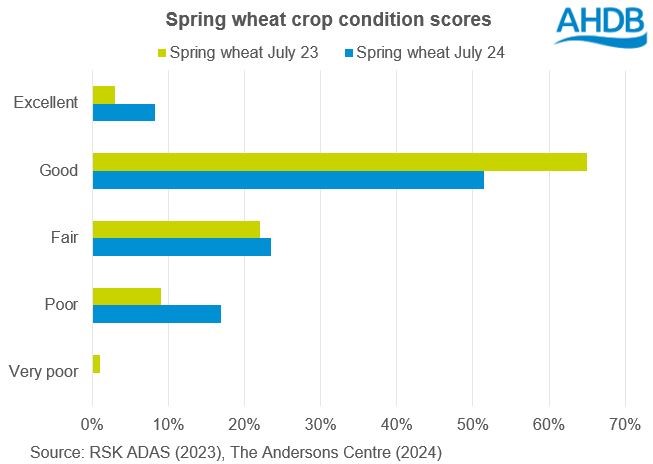
Winter barley
The percentage of the GB winter barley crop rated as either good or excellent is 69%. This is up from the 62% last month, but down from 84% a year ago.
The winter barley crop is starting to turn golden, and sunshine would be welcomed for this crop now to swell the emerging grain. It has coped with the poor winter weather conditions well and some farms appear to have big yields in the ear. If the crops can remain standing for another few weeks, the finished product might be quite good. Winter barley was more established last autumn when the deluges began, so had a greater resilience than the majority of wheat crops. Even in the worst hit regions of the Midlands, many fields are looking comparatively strong.
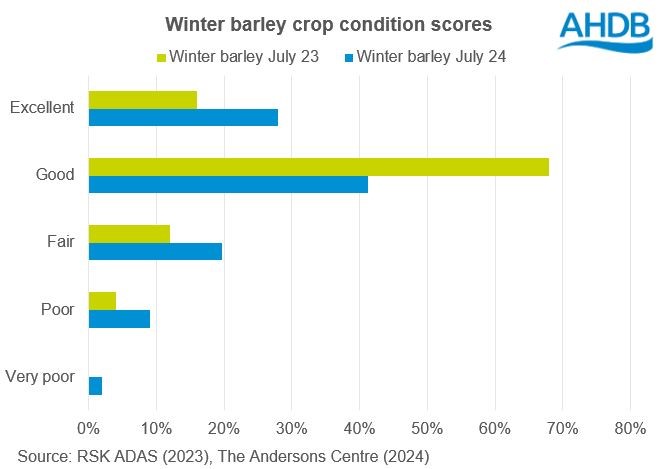
Spring barley
Across all regions, 71% of spring barley is now classified as either good or excellent, up from 55% last month. This is also a higher proportion that the same point last year, when just 53% was rated as in good or excellent condition. The spring has provided excellent growing conditions on the whole. Flag leaves are now emerging.
Short of the need for sunshine, spring crops including barley could offer the best of a very difficult year for combinable cropping in the UK.
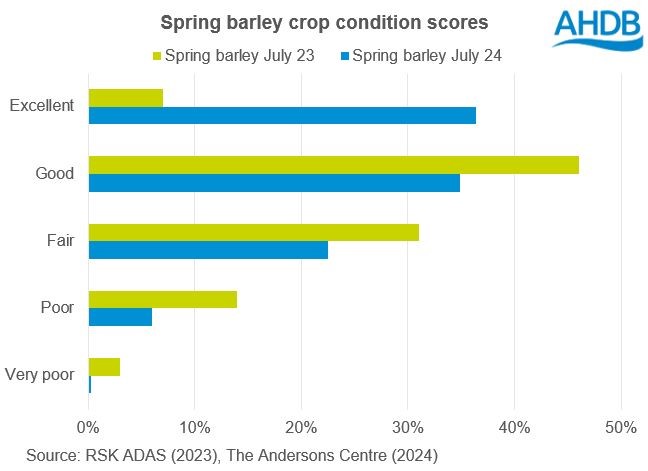
Oats
Overall the oat crop is looking well and strong, especially spring crops, although some look rather stressed following the heavy rain, for example in Scotland.
Across GB, 57% of winter oats are rated as good or excellent, up from 52% last month, but still well below the 74% with this rating a year ago.
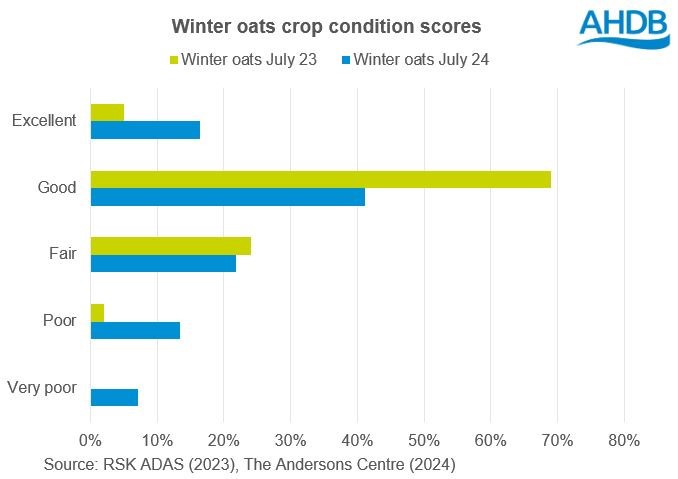
For spring oats, the combined good or excellent rating is 77% across all regions, up from 73% last month. A year ago, 69% of spring oats were rated good or excellent.
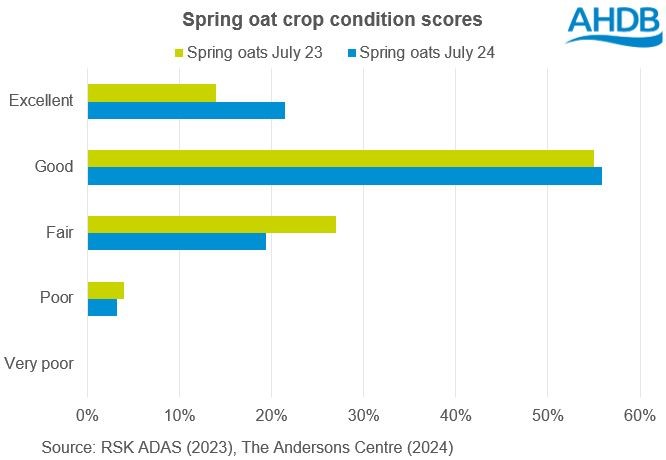
Oilseed rape
The national rating for winter oilseed rape is 54% as either good or excellent, up from the 49% last month. But it is still below last year’s 63%.
Oilseed rape is now in the process of ripening, and some desiccation has already taken place. Gaps in fields may have been filled with weeds so cleaning might be required ahead of harvest.
Overall yield will be lifted when the failed land is taken out of the equation, and this should not be overlooked when all is completed. Crops in the West generally look better than in the Midlands or East.
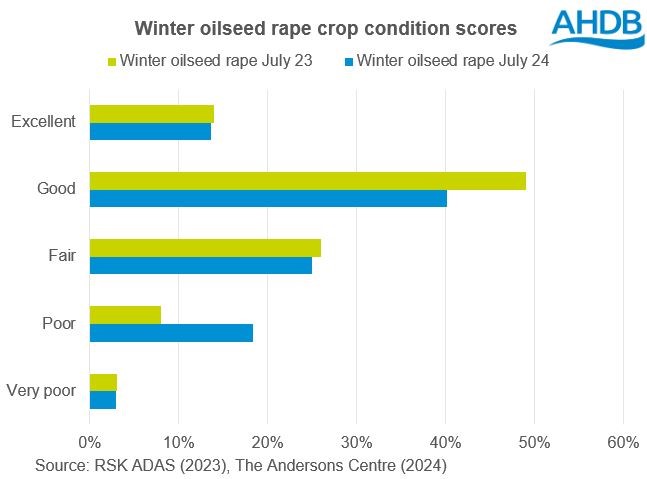
Due to limited data, spring oilseed rape information is not available.
How to use the dashboard
- Use the drop down menu at the top of the first chart to view the crop conditions of a particular crop in each region.
- Use the drop down menus at the top of the second chart to view the percentage of a crop at each growth stage. The drop down menus can also be used to show the information for a particular region.
Historical crop development reports
While AHDB seeks to ensure that the information contained on this webpage is accurate at the time of publication, no warranty is given in respect of the information and data provided. You are responsible for how you use the information. To the maximum extent permitted by law, AHDB accepts no liability for loss, damage or injury howsoever caused or suffered (including that caused by negligence) directly or indirectly in relation to the information or data provided in this publication.
All intellectual property rights in the information and data on this webpage belong to or are licensed by AHDB. You are authorised to use such information for your internal business purposes only and you must not provide this information to any other third parties, including further publication of the information, or for commercial gain in any way whatsoever without the prior written permission of AHDB for each third party disclosure, publication or commercial arrangement. For more information, please see our Terms of Use and Privacy Notice or contact the Director of Corporate Affairs at info@ahdb.org.uk © Agriculture and Horticulture Development Board. All rights reserved.

